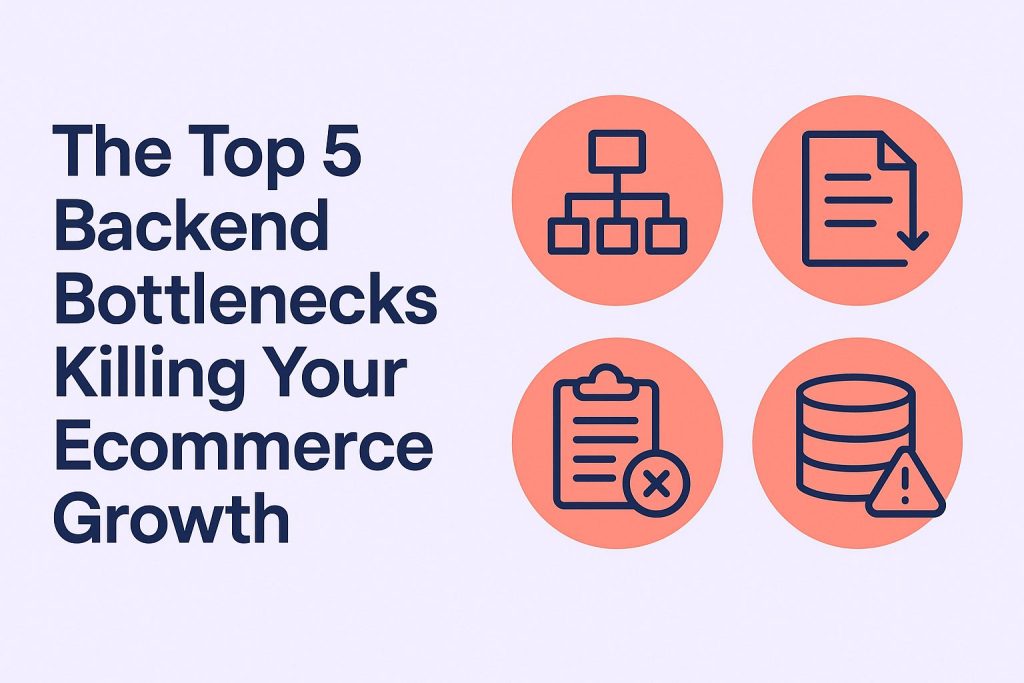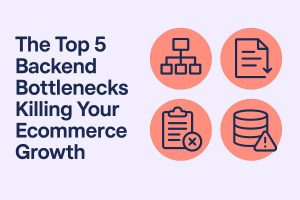Even when your storefront looks polished, hidden snags in your backend can throttle growth. As your ecommerce sales climb, it’s easy to focus on marketing and customer experience – all the shiny stuff – and overlook the small operational problems piling up behind the scenes. Unfortunately, these quiet bottlenecks can quietly chip away at your margins and morale until growth stalls. In this post we’ll unpack the top five backend bottlenecks killing ecommerce growth – from unwieldy SKU complexity to data silos – and show how the right infrastructure (like ToolE’s integrated platform) can clear the path to scalable success.
1. SKU Complexity and Sprawl
It feels natural that more product variations mean more sales – who wouldn’t want extra colors, sizes, or bundles? But too many SKUs (stock-keeping units) can create chaos. Each additional variant adds work and risk. As one fulfillment expert warns, more SKUs = more room for mistakes. What starts as choice for the customer becomes drag on your operation. Growing ecommerce brands often underestimate this – they focus on variety but forget the cost of complexity.

Why it’s overlooked: Early-stage teams may not mind juggling 50 SKUs. When it goes to 500, efficiency crumbles. It often takes a crisis – missed orders or stockouts – before entrepreneurs admit that catalog sprawl is suffocating their growth.
Hidden costs: Large catalogs lead to inventory errors, 3PL frustration, and lost focus on top sellers. Behind the scenes you’ll see spiked return costs and plummeting fulfillment speeds as teams scramble to handle oddball orders.
How ToolE helps: ToolE’s infrastructure brings clarity to SKU chaos. Its integrators let you group related products and sync variants across channels, while centralizing analytics so you know which SKUs truly drive profit. In practice, ToolE can help retire slow-moving SKUs or adjust bundles without upending your listings, keeping your catalog lean and your margins healthy.
2. Inefficient Order Routing
As your business grows, orders may come in from multiple channels and need fulfillment from different locations (multiple warehouses, 3PLs, dropshippers, etc.). If you’re still routing orders manually or with simple rules, it’s a recipe for slow delivery and errors. Without automation, orders can be sent to the wrong warehouse or held up while managers decide where to ship. This inefficiency often goes unnoticed in the early days of ecommerce, but it’s a hidden growth killer. In short, advanced routing slashes transit times and mistakes.
Why it’s overlooked: Small stores might ship everything themselves, so the pain is mild. But as you add locations or 3PL partners, the sheer volume of orders overwhelms manual routing. Without real-time logistics tech, even a slight misroute means parcels circle the country for nothing.
Hidden costs: Inefficient routing adds days (and cost) to delivery. Customers notice slow shipping or see “out of stock” messages when it’s really just a misrouted order. These bottlenecks erode trust and raise return rates, all while you think you’re selling normally.
How ToolE helps: ToolE acts as a central order hub. Its Amazon/Shopify integrators automatically pull all orders into one dashboard and apply smart rules. Need to ship from closest warehouse? Done. Priority certain SKUs? Handled. ToolE’s system ensures every order is sent the optimal way, so you avoid the hidden delays and extra fees that kill customer satisfaction.
3. Manual Product Listings
It’s amazing how many fast-growing stores still rely on copy/paste to push products live. Manually creating and updating listings on each marketplace might seem fine when you have a few products, but it quickly becomes a serious bottleneck. Every time you launch a new item or tweak pricing, you (or someone on your team) has to update every channel by hand – introducing typos, wrong images, or missing descriptions. This inconsistency can directly cost sales. In practice this means carts are abandoned (customers see errors or outdated info) and SEO rankings suffer.
Why it’s overlooked: In the rush of growth, sellers focus on adding more SKUs or marketing, not on tedious listing tasks. At first, a few errors here and there don’t raise alarms. But as order volume spikes, missing or wrong product info means a direct hit to conversions that could have been easily prevented.

Hidden costs: Expect higher return rates, negative reviews, and wasted time fixing mistakes. Designers or managers juggling multiple Excel sheets often don’t realize how much their errors cost in lost revenue.
How ToolE helps: ToolE’s marketplace integrator automates the drudgery. It automates listing creation and synchronization across channels, so the moment you update a product in one place it propagates everywhere. No more dual entries or forgotten edits. That means consistent, accurate listings on Shopify, Amazon, eBay, etc., without extra labor. With these tasks on autopilot, your team can focus on strategy instead of spreadsheets.
4. Inventory and Stock Management
Nothing kills sales like selling what you don’t have (or missing sales on what you do have). Manual or infrequent inventory updates are a silent killer of ecommerce trust and profit. If your stock levels aren’t synced in real time across systems, you’ll oversell on busy items and stock out on bestsellers – often without knowing it. Customers expect accuracy: if they buy something that shows as “in stock” only to get an email about a backorder, loyalty tanked.
Why it’s overlooked: Early on, shops often use manual counts or single-channel tools. It seems cheaper than investing in systems, so founders delay it. The pain only hits hard during big sales or peak season, and by then operations are already strained.
Hidden costs: Overselling generates refunds, chargebacks and extra shipping to reroute backorders. Stockouts mean marketplace listings get suppressed or lose ranking. Both cases bleed revenue. Moreover, capital ties up in hidden deadstock that should have been culled.
How ToolE helps: ToolE enforces real-time sync. Its integrators continuously sync inventory levels across all your sales channels and warehouses. In effect, it provides accurate data and inventory levels to prevent stockouts and overselling. You’ll always know exactly how many units are left where, and all channels reflect that instantly. The result: no double-sold items, no missed opportunities.
5. Disconnected Systems and Data Silos
As you onboard more sales channels, suppliers, and tools, it’s easy for data to splinter off into silos – separate spreadsheets, disjointed platforms, and manual handoffs. These invisible gaps can cripple operations. In fact, studies show data silos are shockingly common in retail. For e-commerce, that means demand forecasting, inventory planning, and order management all suffer. In practice you may have marketing data in one system, inventory in another, and shipping in yet another – none of which talk to each other.
Why it’s overlooked: Many sellers start by patching together familiar tools (Excel, a free CMS plugin, a 3PL’s portal). It seems fine when sales are low, but those workarounds don’t scale. Eventually staff waste hours reconciling mismatched reports instead of growing the business.
Hidden costs: The fallout is subtle but real: poor forecasts, excess safety stock, and missed reorder alerts. You might launch a promotion based on the wrong data, overspend on expedited shipping, or ship the wrong quantities. It erodes efficiency across the board.
How ToolE helps: ToolE is built to break down these silos. Its suite of eTools connects your storefronts, marketplaces, ERPs, and logistics into one platform. Instead of bouncing between disconnected dashboards, you get a unified picture of products, orders, and customers. All your backend systems sync through ToolE, so nothing falls through the cracks. That consolidated visibility not only prevents errors, but also empowers you to make smart growth decisions with confidence.
In ecommerce, every backend improvement compounds. By tackling these hidden bottlenecks – SKU sprawl, clunky routing, manual listings, inventory messes, and siloed data – you remove the brakes on growth. ToolE’s integrated infrastructure is designed for exactly this: automating sync and connectivity so your team can focus on selling, not firefighting. Ready to supercharge your operations?
Contact ToolE today for a free consultation or demo, and discover how our ecommerce platforms can streamline your backend and fuel your next phase of growth.





